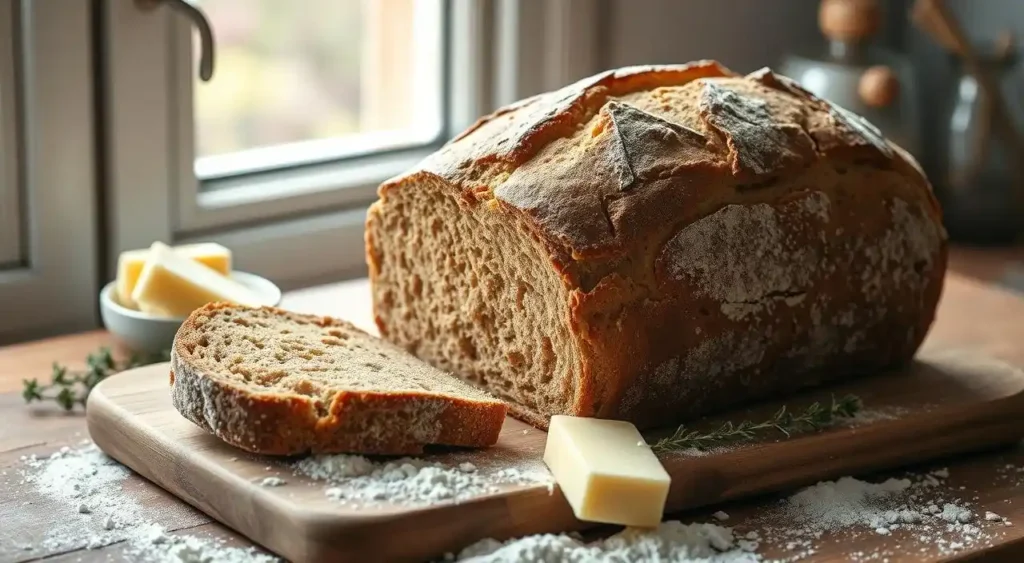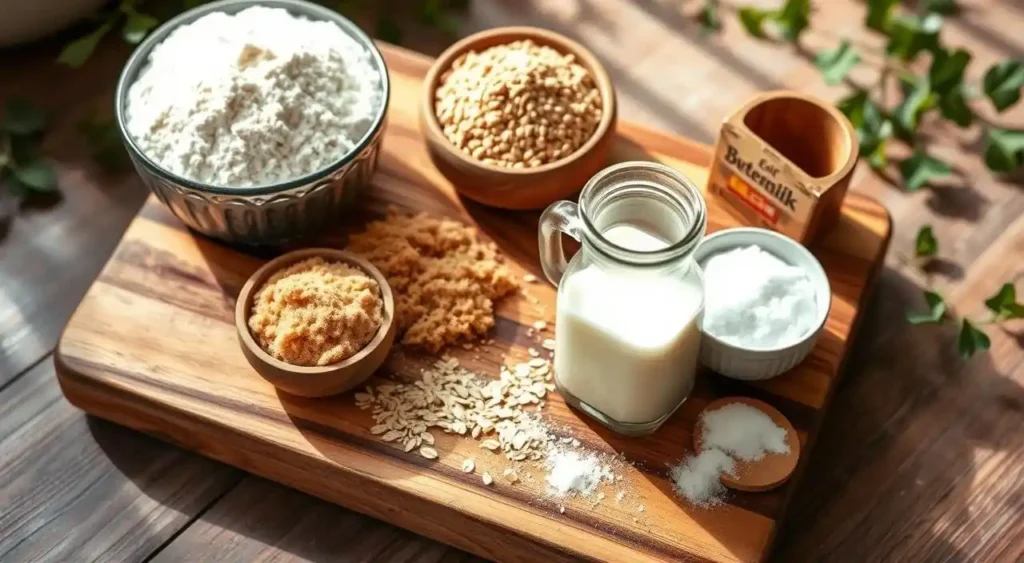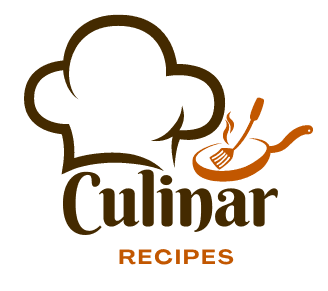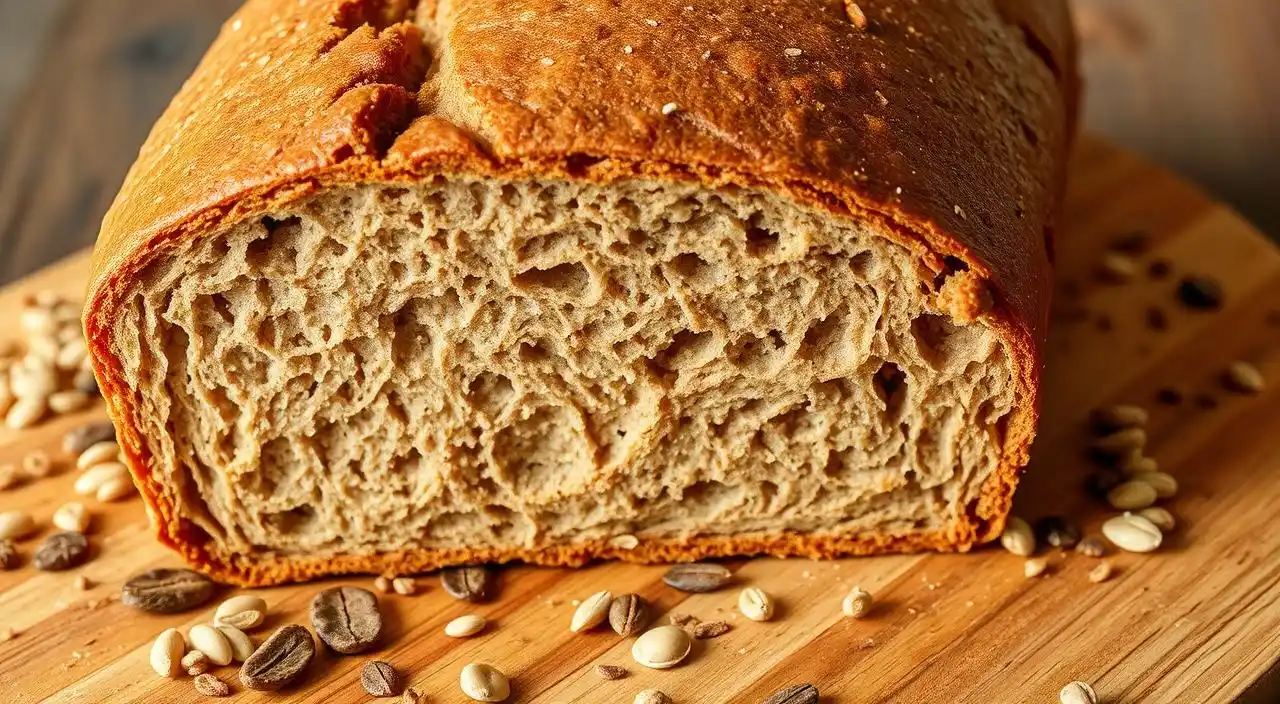The smell of freshly baked Irish brown bread takes me back to my grandmother’s cozy farmhouse. There, the sound of dough kneading and the oven crackling filled the air. This simple loaf, with its rough texture and rich flavors, is dear to me. It reminds me of Ireland’s warmth and traditions.
You’ll become skilled at making perfect Irish brown bread as you learn this recipe. You’ll also discover the history and cultural importance of each slice. Let’s explore the origins, variations, and key techniques to bring a bit of Ireland into your home.
Table of Contents
Introduction to Irish Brown Bread Heritage
Irish brown bread, also known as brown soda bread, is a beloved tradition in Irish homes for centuries. It has a rich, earthy flavor and a rustic texture. Learning about Irish brown soda bread and brown soda bread Ireland shows the heart of Irish cuisine.
Origins in Irish Culinary History
The story of Irish brown soda bread starts in the 1800s. It was made with whole wheat flour and baking soda, which were affordable. This bread was quick to make, thanks to baking soda, perfect when ovens were rare.
Cultural Significance in Irish Households
Brown soda bread in Ireland is more than food; it symbolizes Irish culture. It’s shared at celebrations, bringing families and communities together. It shows the spirit of Ireland and the importance of tradition.
Traditional vs. Modern Variations
The traditional Irish brown soda bread recipe has stayed the same for years. But new recipes have been added to meet changing tastes. This keeps the bread a favorite in Irish kitchens.

“Irish brown bread is more than just a food – it’s a cultural touchstone that connects generations and nourishes the soul.”
Essential Ingredients for Perfect Irish Brown Bread
Making true Irish brown bread needs the right ingredients. It’s all about mixing the right parts to get the bread’s special taste and feel.
At the core of the brown bread recipe, Irish is whole wheat flour. It gives the bread a rich, nutty flavor and a dense texture. Buttermilk adds moisture and helps the baking soda work its magic.
Baking soda is what makes the bread light and airy. A bit of salt also goes in. It balances the sweetness and brings out the flavors of the other ingredients.
To make the perfect Irish brown bread, you need to get the mix just right. The key is whole wheat flour, buttermilk, baking soda, and salt. With these, you can make a loaf that tastes like Irish brown bread.
| Ingredient | Quantity | Purpose |
|---|---|---|
| Whole Wheat Flour | 3 cups | Provides the hearty, nutty flavor and dense texture |
| Buttermilk | 2 cups | Adds moisture and tangy richness, activates the baking soda |
| Baking Soda | 1 teaspoon | The essential leavening agent responsible for the bread’s lightness |
| Salt | 1 teaspoon | Enhances the overall flavor profile and balances the sweetness |

Kitchen Tools and Equipment You’ll Need
Making delicious Irish brown bread needs more than just the right ingredients. It would be best to have the right kitchen tools and equipment. Let’s examine the essential items and optional gadgets for making the perfect loaf.
Essential Baking Tools
- Large mixing bowl: You’ll need a big bowl to mix and let the dough rise.
- Wooden spoon or dough whisk: These tools help mix and knead the dough well.
- Baking sheet or loaf pan: Good bakeware ensures your bread bakes evenly.
- Oven mitts: Keep your hands safe when handling hot bakeware.
Optional Equipment for Better Results
While the basics work, some extra tools can make your baking better:
- Stand mixer with dough hook: This appliance kneads the dough for you, saving time.
- Banneton bread-proofing basket: It helps the dough keep its shape and crust.
- Bread lame or sharp knife: Score the dough top before baking for better expansion.
Measuring Tools Requirements
Getting the measurements right is key for perfect texture and rise. Make sure you have these tools:
- Measuring cups and spoons: Accurate dry ingredient portions are crucial.
- Digital kitchen scale: Weighing ingredients, especially flour, leads to better results.
- Thermometer: Check the oven temperature for the best baking conditions.
With the right tools and equipment, you can make delicious Irish brown or brown soda bread in your kitchen.

Understanding Different Types of Flour for Irish Brown Bread
Choosing the right flour is key to making the perfect Irish brown soda bread. Whole wheat flour is often used, but other flours work well. This makes the bread hearty and full of flavor.
Whole wheat flour gives Irish brown bread its dense, nutty taste. It’s made from the whole wheat kernel, keeping the germ and bran. You can also try spelled rye or a mix of whole wheat and all-purpose flours for different tastes and textures.
White whole wheat flour is a good choice for a lighter Irish brown soda bread. It’s made from lighter wheat, making the bread softer and more cake-like.
| Flour Type | Texture | Flavor | Nutrition |
|---|---|---|---|
| Whole Wheat | Dense, Coarse | Nutty, Earthy | High in Fiber, Vitamins, and Minerals |
| White Whole Wheat | Lighter, Softer | Milder, Sweeter | Nutrient-Rich, Less Dense than Traditional Whole Wheat |
| Spelt | Slightly Chewy | Slightly Nutty, Slightly Sweet | High in Fiber, Protein, and Nutrients |
| Rye | Dense, Coarse | Earthy, Robust | High in Fiber, Minerals, and B Vitamins |
The right flour for your Irish brown bread depends on what you like. Try different flours to find the perfect match for your taste. This will make your bread even more special.
Step-by-Step Mixing Process
Making the perfect Irish brown bread starts with mixing carefully. By following a few steps, you can mix your ingredients well. This ensures your dough is just right. Let’s look at how to mix this Irish favorite.
Proper Ingredient Incorporation
First, get all your brown bread recipe Irish ingredients ready. This includes flour, baking soda, salt, and buttermilk. Whisk the dry ingredients together in a big bowl to mix them well.
Then, make a well in the center. Slowly add the buttermilk, mixing it into the dry ingredients with a spoon or spatula.
Dough Consistency Guidelines
The dough should be slightly sticky but firm. Don’t overmix, as this makes the bread dense. Instead, fold the dough gently until everything is just mixed.
Common Mixing Mistakes to Avoid
- Overmixing the dough can result in heavy and dense bread
- Failing to incorporate the buttermilk evenly leads to uneven rise and texture
- Using the wrong type of flour which can affect the overall structure and flavor of the bread
- Forgetting to preheat the oven, which can impact the final baking process
You’ll make great Irish brown bread by following these steps and avoiding common mistakes. It will have the real flavors and textures of Irish bread.
Kneading and Shaping Techniques
Learning to knead and shape your Irish brown soda bread dough is crucial. It helps you get the perfect texture and the traditional round shape. Here are some tips to improve your brown soda bread and Ireland baking skills.
The Kneading Process
Kneading is important for developing the gluten in your dough. This makes your bread chewy yet tender. Here’s how to knead your Irish brown soda bread dough:
- Start by lightly flouring your work surface to prevent sticking.
- Using the heel of your hand, push the dough away from you, then fold it back towards you.
- Give the dough a quarter turn and repeat the pushing and folding motion.
- Continue this process for 5-7 minutes, working the dough until it becomes smooth, elastic, and springs back when poked.
Shaping the Loaf
Shaping your brown soda bread Ireland dough into a classic round loaf is the final step before baking. Follow these simple steps for a picture-perfect result:
- Gently shape the dough into a round ball, tucking the edges under to create a smooth top.
- Place the shaped dough into a lightly greased round baking pan or on a parchment-lined baking sheet.
- Use a sharp knife to score a deep cross on the top of the loaf, which helps it rise evenly during baking.
With the right kneading and shaping techniques, you’ll be ready to bake authentic, delicious Irish brown soda bread right at home.
Proper Baking Temperature and Timing
Baking the perfect Irish brown bread requires the right oven temperature and timing. Understanding the best baking conditions is key. It helps ensure your bread turns out just right.
Oven Preparation Tips
Start by preheating your oven to 375°F (190°C). This temperature is perfect for evenly baking the brown brown bread. It prevents the crust from getting too dark. Also, using a baking stone or sheet helps with even heat. This leads to a better rise and texture.
Temperature Control Strategies
- Use an oven thermometer to check the temperature. Adjust it if needed to keep it at 375°F (190°C).
- Try not to open the oven door too often. This can mess with the temperature and affect your Irish brown bread.
- If the crust is browning too fast, lower the temperature by 25°F (14°C). This slows down the baking and prevents over-browning.
Following these tips, you’ll bake a perfect loaf of brown brown bread. It will have the rich, authentic flavors of traditional Irish brown bread.
Traditional Irish Brown Bread Variations
The classic Irish brown soda bread is a favorite in Irish homes. Over time, it has grown to include many tasty regional and personal twists. Discover the colorful world of brown bread recipes and Irish variations that honor Ireland’s rich food heritage.
Seeded Soda Bread
Adding a mix of seeds like sunflower, pumpkin, or sesame to your Irish brown soda bread dough is a great idea. These toasted seeds add a nice crunch and extra nutrition.
Cranberry and Walnut Bread
Dried cranberries and chopped walnuts are a wonderful addition to the brown bread recipe Irish. They bring a sweet tartness and a rich, buttery taste. This version is ideal for those who love a bit of sweetness and a gourmet touch.
Caraway Seed Bread
Caraway seeds give traditional Irish brown soda bread its unique flavor. This version adds a savory, earthy taste that goes well with soups, stews, and cheese platters.
| Variation | Key Ingredients | Flavor Profile |
|---|---|---|
| Seeded Soda Bread | Sunflower, pumpkin, sesame seeds | Nutty, textural |
| Cranberry and Walnut Bread | Dried cranberries, chopped walnuts | Sweet, sophisticated |
| Caraway Seed Bread | Caraway seeds | Savory, earthy |
These are just a few examples of the many tasty brown bread recipes in Irish variations. They celebrate Ireland’s rich food traditions. Try different flavors and ingredients to find your favorite twist on this classic.
Storage and Freshness Tips
Keeping your homemade Irish brown bread fresh is key to enjoying it. Knowing how to store it and its shelf life is essential. These tips will help your bread stay tasty and crusty for longer.
Proper Storage Methods
Storing your Irish brown bread right is crucial. It helps keep it fresh by preventing moisture loss and air exposure. Here are some tips:
- Wrap the loaf tightly in plastic wrap or place it in an airtight container at room temperature.
- For longer-term storage, consider freezing the bread. Slice it first, then wrap the individual slices in foil or plastic wrap before placing them in the freezer.
- Avoid storing Irish brown bread in the refrigerator, as the cool, dry air can cause the crust to become stale and the interior to dry out.
Shelf Life Guidelines
Proper storage can extend your bread’s life. But it’s still important to know its shelf life. Here’s what you can expect:
| Storage Condition | Shelf Life |
|---|---|
| Room temperature, wrapped | 3-4 days |
| Frozen, sliced and wrapped | 2-3 months |
These are just guidelines. The actual shelf life may vary. Always check for mold or an off smell before eating.
Serving Suggestions and Pairings
Enjoying Irish brown soda bread opens up a world of possibilities. This brown brown bread can be enjoyed in many ways, both old and new. It can make your meals more special.
Try Irish brown soda bread with a full Irish fry-up for a traditional Irish breakfast. Add crispy bacon, grilled tomatoes, and creamy scrambled eggs. The bread’s strong taste goes well with the breakfast’s bold flavors.
- Pair brown bread with fresh butter and jam for a delightful morning treat.
- Enjoy Irish brown soda bread toasted and topped with avocado and a sprinkle of sea salt for a modern, nutrient-rich breakfast.
- Serve brown brown bread alongside a hearty soup or stew for a comforting and satisfying lunch or dinner.
- Use Irish brown soda bread as the base for open-faced sandwiches, layering it with your favorite toppings like smoked salmon, sliced cheese, or roasted vegetables.
Irish brown soda bread is a true delight that can improve any meal. Try different pairings and serving suggestions to find your favorite way to enjoy this iconic Irish treat.
Troubleshooting Common Baking Issues
Baking the perfect Irish brown bread is a fun challenge. But, it can have its problems. We’ve got solutions for common issues like texture and rising problems.
Texture Problems and Solutions
If your Irish brown bread is too dense, it might be due to overmixing. This makes the dough tough. Or, if it’s too wet, it could be dense and gummy. Try adjusting the flour and liquid ratio for a better texture.
If the bread is too crumbly or dry, you might have mixed it too little or used too much flour. Watch the dough’s consistency. Add more liquid if it’s too dry.
Rising and Baking Challenges
Have trouble with your bread not rising? Check your yeast. Old or inactive yeast won’t help. Also, make sure your oven is at the right temperature. A cool oven can stop the bread from rising.
Try baking at a lower temperature if the outside browns too fast but the inside is still raw. Cover the loaf with foil to stop over-browning. Brush the top with egg or milk before baking for a golden crust.
Every oven and dough is different. So, don’t be afraid to try new things. Keep adjusting until you get your Irish brown bread just right.
Health Benefits of Irish Brown Bread
Irish brown soda bread is more than just a tasty treat. It’s packed with health benefits. Made from whole grain flours, it shows natural ingredients can be super nutritious.
This bread is full of fiber, thanks to whole grains like wheat or rye. This fiber is great for your digestive system. It also helps you feel full longer and might lower the risk of some diseases.
Irish brown soda bread is also rich in vitamins and minerals. It has B vitamins, iron, and magnesium. These nutrients boost energy, support the immune system, and help bone health.
Compared to white bread, Irish brown soda bread has a lower glycemic index. This means they don’t cause blood sugar spikes as quickly. This is good for people with diabetes or who want to stabilize their blood sugar.
“The health benefits of irish brown soda bread are a testament to the wisdom of traditional Irish culinary practices. This simple, rustic bread is a nutritional powerhouse that deserves a place on the table of health-conscious consumers.”
Enjoying a slice of Irish brown soda bread with coffee or as a sandwich base is healthy. It’s a nutritious treat that can improve your health and well-being.
Tips for Making Irish Brown Bread Gluten-Free
Enjoying Irish brown bread doesn’t have to be hard for those with gluten sensitivities. A few simple changes can make the classic recipe gluten-free. This way, you can still enjoy the taste of this Irish favorite.
Gluten-Free Flour Alternatives
Finding the right flour substitutes is key for gluten-free Irish brown bread. Instead of wheat flour, try a mix of:
- Brown rice flour
- Buckwheat flour
- Oat flour (make sure it’s gluten-free)
- Almond flour
Try different flour mixes to get the right texture and taste. This will help you get close to authentic Irish brown bread.
Adjusting the Recipe
After picking your gluten-free flours, you’ll need to tweak the recipe:
- Use more liquid, like milk or buttermilk, because gluten-free flours are drier.
- Add something like xanthan gum or psyllium husk to help the dough stay together.
- Change the baking time and temperature. Gluten-free breads might need longer to cook.
Don’t be afraid to try different things until you get it just right. This will help you make the best gluten-free Irish brown bread.
You can enjoy Irish brown bread without gluten with creativity and careful attention. This way, you can share this tasty tradition with everyone, no matter their dietary needs.
Conclusion
Irish brown bread is a true culinary gem, blending rich culture with delicious taste. It started in the Irish countryside and now delights people everywhere. This bread is not just food; it symbolizes Ireland’s love for good food.
Irish brown bread is special whether you love the traditional taste or enjoy new recipes. It lets you connect with Ireland’s food heritage. You can share a piece of Ireland with your family and friends by baking it yourself.
Start your Irish brown bread journey today. This article will help you make a loaf that’s both nourishing and full of flavor. Enjoy every step, relish the outcome, and let Irish brown bread take you on a taste tour of Ireland.

